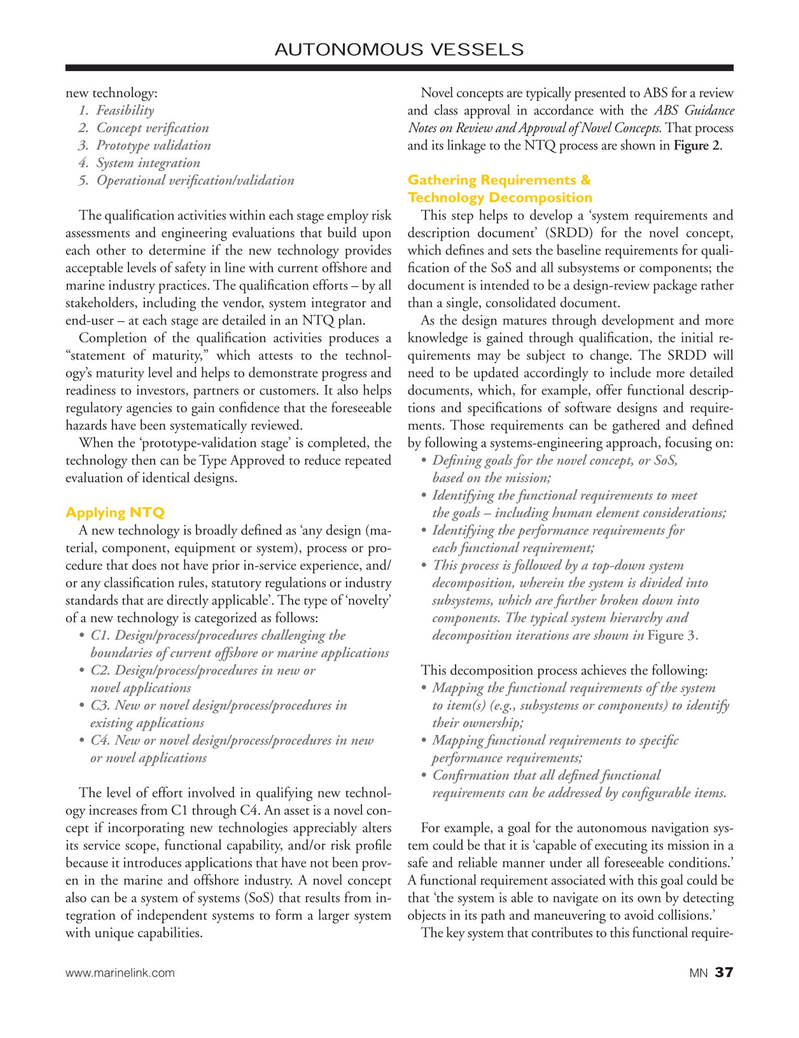
Page 37: of Marine News Magazine (December 2017)
Innovative Products & Boats- 2017
Read this page in Pdf, Flash or Html5 edition of December 2017 Marine News Magazine
AUTONOMOUS VESSELS new technology: Novel concepts are typically presented to ABS for a review 1. Feasibility and class approval in accordance with the ABS Guidance 2. Concept veri? cation Notes on Review and Approval of Novel Concepts. That process 3. Prototype validation and its linkage to the NTQ process are shown in Figure 2.
4. System integration 5. Operational veri? cation/validation Gathering Requirements &
Technology Decomposition
The quali? cation activities within each stage employ risk This step helps to develop a ‘system requirements and assessments and engineering evaluations that build upon description document’ (SRDD) for the novel concept, each other to determine if the new technology provides which de? nes and sets the baseline requirements for quali- acceptable levels of safety in line with current offshore and ? cation of the SoS and all subsystems or components; the marine industry practices. The quali? cation efforts – by all document is intended to be a design-review package rather stakeholders, including the vendor, system integrator and than a single, consolidated document.
end-user – at each stage are detailed in an NTQ plan. As the design matures through development and more
Completion of the quali? cation activities produces a knowledge is gained through quali? cation, the initial re- “statement of maturity,” which attests to the technol- quirements may be subject to change. The SRDD will ogy’s maturity level and helps to demonstrate progress and need to be updated accordingly to include more detailed readiness to investors, partners or customers. It also helps documents, which, for example, offer functional descrip- regulatory agencies to gain con? dence that the foreseeable tions and speci? cations of software designs and require- hazards have been systematically reviewed. ments. Those requirements can be gathered and de? ned
When the ‘prototype-validation stage’ is completed, the by following a systems-engineering approach, focusing on: technology then can be Type Approved to reduce repeated • De? ning goals for the novel concept, or SoS, evaluation of identical designs. based on the mission; • Identifying the functional requirements to meet
Applying NTQ the goals – including human element considerations;
A new technology is broadly de? ned as ‘any design (ma- • Identifying the performance requirements for terial, component, equipment or system), process or pro- each functional requirement; cedure that does not have prior in-service experience, and/ • This process is followed by a top-down system or any classi? cation rules, statutory regulations or industry decomposition, wherein the system is divided into standards that are directly applicable’. The type of ‘novelty’ subsystems, which are further broken down into of a new technology is categorized as follows: components. The typical system hierarchy and • C1. Design/process/procedures challenging the decomposition iterations are shown in Figure 3.
boundaries of current offshore or marine applications • C2. Design/process/procedures in new or This decomposition process achieves the following: novel applications • Mapping the functional requirements of the system • C3. New or novel design/process/procedures in to item(s) (e.g., subsystems or components) to identify existing applications their ownership; • C4. New or novel design/process/procedures in new • Mapping functional requirements to speci? c or novel applications performance requirements; • Con? rmation that all de? ned functional
The level of effort involved in qualifying new technol- requirements can be addressed by con? gurable items.
ogy increases from C1 through C4. An asset is a novel con- cept if incorporating new technologies appreciably alters For example, a goal for the autonomous navigation sys- its service scope, functional capability, and/or risk pro? le tem could be that it is ‘capable of executing its mission in a because it introduces applications that have not been prov- safe and reliable manner under all foreseeable conditions.’ en in the marine and offshore industry. A novel concept A functional requirement associated with this goal could be also can be a system of systems (SoS) that results from in- that ‘the system is able to navigate on its own by detecting tegration of independent systems to form a larger system objects in its path and maneuvering to avoid collisions.’ with unique capabilities. The key system that contributes to this functional require- www.marinelink.com MN 37

 36
36

 38
38
